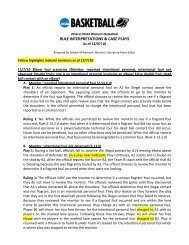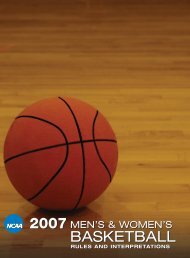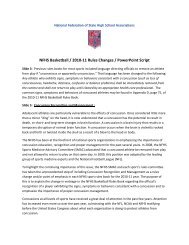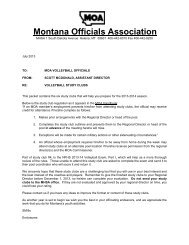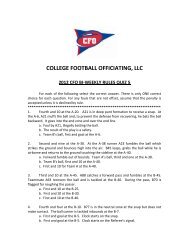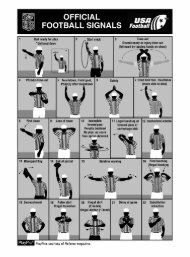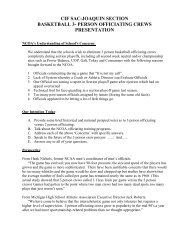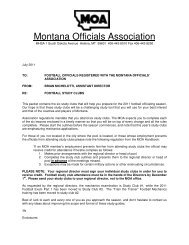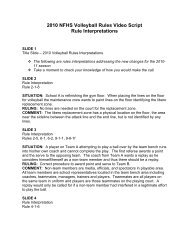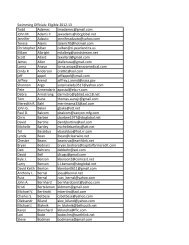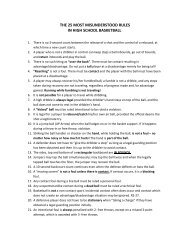2011-12 AND 2012-13 MEN'S AND WOMEN'S RULES - NAIA
2011-12 AND 2012-13 MEN'S AND WOMEN'S RULES - NAIA
2011-12 AND 2012-13 MEN'S AND WOMEN'S RULES - NAIA
Create successful ePaper yourself
Turn your PDF publications into a flip-book with our unique Google optimized e-Paper software.
RULE 4 / DEFINITIONS57<br />
Art. 5. It shall be illegal to extend one’s arms fully or partially, other than<br />
vertically, so that the freedom of movement of an opponent is hindered when<br />
contact with the extended arms occurs.<br />
Art. 6. It shall be illegal to extend one’s elbow(s) and make contact when one’s:<br />
a. Hands are on one’s hips;<br />
b. Hands are held near one’s chest; or<br />
c. Arms are held approximately horizontal to the playing court when not<br />
holding the ball.<br />
Note: These illegal positions are most commonly used when rebounding,<br />
screening or in the various aspects of post play.<br />
Art. 7. The following shall be considered excessive swinging:<br />
a. When arm(s) and elbow(s) are swung about while using the shoulders as<br />
pivots, and the speed of the extended arm(s) and elbow(s) exceeds that of<br />
the rest of the body as it rotates on the hips or on the pivot foot; or<br />
b. When the speed and vigor with which the arm(s) and elbow(s) are swung<br />
is such that injury could result if another player were contacted.<br />
Section 37. Held Ball<br />
Art. 1. A held ball occurs when an opponent places his or her hand(s):<br />
a. So firmly on the ball that control cannot be obtained without undue<br />
roughness; or<br />
b. On the ball to prevent an airborne player from throwing the ball or<br />
attempting a try and both players return to the playing court with both<br />
hands on the ball or the airborne player returns to the playing court never<br />
losing control of the ball.<br />
Section 38. Holding<br />
Art. 1. Holding is illegal personal contact with an opponent who interferes with<br />
the opponent’s freedom of movement.<br />
Section 39. Inadvertent Whistle<br />
Art. 1. An inadvertent whistle occurs any time an official blows the whistle as an<br />
oversight and does not have a call to make.<br />
Section 40. Incidental Contact<br />
Art. 1. All contact shall not constitute a foul. When 10 players move rapidly in a<br />
limited area, some contact is certain to occur. Incidental contact shall be contact<br />
with an opponent that is permitted and does not constitute a foul.<br />
Art. 2. Contact that is incidental to an effort by an opponent to reach a loose<br />
ball, or contact that results when opponents are in equally favorable positions<br />
to perform normal defensive or offensive movement, should be permitted even<br />
though the contact may be severe or excessive.<br />
Art. 3. Contact that does not hinder the opponent from participating in normal<br />
defensive or offensive movements shall be considered incidental.<br />
Art. 4. A player who is screened within his or her visual field shall be expected to<br />
avoid contact with the screener by stopping or avoiding the screener.



